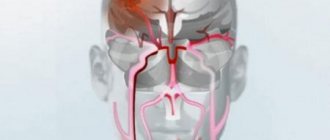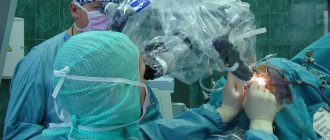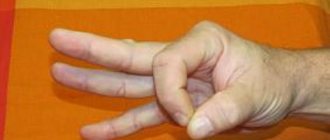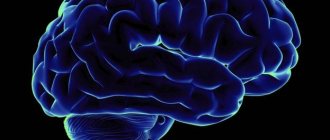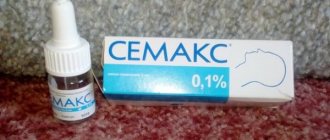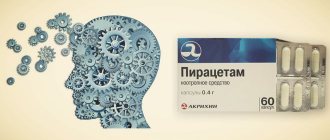16.08.2020
Stupor during a stroke is a condition in which the patient's consciousness is impaired. This pathological process develops when metabolism in the head is disturbed. When the disease occurs, the sleep-wake cycle is disrupted. If pathology occurs, the patient is recommended to provide first aid and be sent to a medical center for examination.
The main cause of stupor is stroke. It develops when the body is exposed to other provoking factors. Stunning is diagnosed in patients after traumatic brain injuries. If intoxication of the body is observed while taking certain medications, this leads to illness. During a stroke, oxygen starvation of the brain occurs, which leads to stupor
.
If a person takes sleeping pills in excess, this leads to pathology. In tumor processes with metastasis, a pathological process is observed in the head. People who regularly drink alcohol or drugs are at risk. The pathological process is diagnosed with epilepsy or seizures, which are a symptom of a stroke.
Stupor develops after heat or sunstroke. If, during a stroke, severe viral or bacterial infections occur in the form of meningitis, encephalitis, viral hepatitis, then this becomes the cause of pathology. It is diagnosed in stroke patients when the body is dehydrated. The provoking factor is a severe allergic reaction to drugs that are used during the recovery period after a stroke.
There are various provoking factors of the pathological process, therefore, during the rehabilitation period after a stroke, the patient is recommended to provide proper care.
Prognosis and chances of survival
Coma after a stroke is a state between life and death associated with complete damage and disruption of the brain and all physiological systems. This is a kind of protective reaction of the body, which has an unsatisfactory prognosis. The likelihood of recovery from coma is rarely recorded and requires long-term rehabilitation.
Sometimes it is necessary to switch off a person's consciousness with medication to prevent life-threatening brain changes.
In the event of compression pressure on brain tissue, swelling, or hemorrhages and bleeding resulting from traumatic brain injuries, the patient is placed in an artificial coma, which can replace anesthesia during times of crisis.
Long-term analgesia allows you to constrict blood vessels, reduce the tension of cerebral flow, and avoid necrosis of brain tissue.
Sedation is caused by the administration of a controlled high dose of special drugs that have a depressant effect on the central nervous system in intensive care conditions.
This condition can last a long time and requires constant monitoring of the patient's condition. Any reactions to external stimuli or movements indicate the possibility of returning consciousness.
The task of the medical staff is to provide assistance in recovering from a coma.
Introduction to sedation has side effects, including complications of the respiratory system (tracheobronchitis, pneumonia, pneumothorex), hemodynamic disorders, renal failure, and neurological pathologies.
Stroke is a dangerous disease, often leading to disability or death.
With extensive damage to brain cells due to hemorrhagic or ischemic stroke, coma occurs.
For any form of the disease, the prognosis is that it will take a long time for the patient to recover from a coma.
Often, a coma during a stroke is diagnosed upon the arrival of an ambulance and requires urgent resuscitation measures.
It should also be taken into account that there is a risk of recurrent hemorrhage in 5% of patients within 3-5 days after a stroke, in 3% of patients - after 4 months, so relapse can only be avoided with surgery.
To relieve the symptoms of coma, resuscitation measures are used, which also includes surgical intervention, which allows you to quickly and effectively remove the patient from this state.
During the operation, bleeding is eliminated and the aneurysm that caused the symptoms of stroke is clipped.
With the sudden onset of coma, the patient loses consciousness, does not wake up for more than 6 hours, and the symptoms increase. This can lead to brain death.
To clarify the diagnosis of the disease, an additional encephalogram is performed.
But in some cases, patients may wake up months or years after falling into a coma. E
This happens only in 9% of cases and is associated with the implementation of unexplored brain reserves. The younger the patient who falls into a coma, the greater the chance of recovery.
Coma is a condition characterized by complete or partial extinction of reflexes caused by an acute circulatory disorder in the brain. A comatose state during a stroke is a serious complication that leads to the death of brain cells irreversibly.
How long does an artificially induced coma last? The procedure for rendering a patient unconscious is called an induced coma. In this condition, the metabolism of brain tissue slows down and cerebral blood flow decreases. Vasoconstriction occurs, which is necessary to reduce intracranial pressure, which in turn helps relieve tissue swelling and eliminate necrosis.
Experts decide how long an induced coma lasts—induction into a comatose state is a controlled process. After the swelling is removed, the necessary therapeutic measures are carried out and the doctor can bring the patient to his senses at any time. Staying in such a state has a number of unpleasant consequences; a side disorder can affect the heart, gastrointestinal motility, kidneys, and also weaken the immune defense.
Information: The first signs of a stroke are expressed by blurred vision, dizziness, confusion and clouding of consciousness. There is also unusual drowsiness and nausea.
It is necessary to surround the patient with care and support. You should instill hope in a person, encourage and praise him for his achievements. Singing will help restore speech; to develop motor skills, you can assemble simple construction sets. It is good to restore memory by playing attention games and solving crossword puzzles.
The help and support of relatives is invaluable during the adaptation period. People who have emerged from a comatose state with partially lost legal capacity with appropriate rehabilitation therapy have a high chance of positive results.
Stupefaction: degrees of depression of consciousness and symptoms
Traditionally, stunned consciousness is usually divided into separate categories depending on the degree of mental depression into disorders: moderate and severe.
Moderate stunned
The main manifestations of moderate severity of stunning syndrome are a noticeable slowdown in all thought processes, significant difficulty in using cognitive resources, and a significant impoverishment of mental potential. With this disorder, the patient experiences a decrease in the possibility of active attention: he is not capable of purposeful, voluntary and controlled concentration of thoughts, vision, hearing on any processes, phenomena, objects.
With moderate deafness, it is possible to establish verbal contact with the individual. However, a person does not answer the question posed immediately, but some time after he hears the question. Often, in order for a subject to respond to an opponent’s statement, it is necessary to repeat the same remark several times. For some people who are in a state of deafness, additional methods of stimulation are required, for example: calling the patient by name, touching his body, or lightly patting his face.
With stunning syndrome, a person adequately perceives and correctly carries out assigned tasks, but he carries out all commands at a slow pace. When exposed to pain receptors, the subject experiences targeted motor, humoral and behavioral reactions.
Externally, the patient looks lethargic, apathetic and exhausted. Those around us notice a significant depletion of facial expressions and gestures. The patient's speech is slow, the patient pronounces phrases in a quiet voice.
A distinctive feature of a moderate degree of deafness is the person’s complete preservation of orientation in his own personality. There are no distortions, exaggerations, or fantasies in the patient’s stories about his own personality. At the same time, the individual has difficulty navigating time: he cannot correctly name the current date and day of the week. He also incorrectly determines his location: a person is not able to accurately indicate in which specific place he is now.
Deep stunned
The leading symptom of a deep degree of deafness is a significant narrowing of mental capabilities, deterioration of almost all intellectual abilities
. The patient is almost constantly in a drowsy state, which is occasionally replaced by episodes of excessive motor activity. At such moments, it seems that the person was abruptly awakened, and, being in a state of half-asleep, he makes random, illogical and useless movements.
With a deep degree of stunned consciousness, verbal contact with the patient can be established with great difficulty. The patient is not able to give an answer immediately after contacting him: the doctor needs to repeatedly repeat the same question, showing persistence and using other stimuli. Almost always the individual answers in monosyllables; it is impossible to hear detailed, complete answers from him. Despite the difficulties of verbal contact, the patient correctly reports his personal information: last name, first name, patronymic, date and place of birth. He correctly names the names of his relatives and accurately indicates his occupation.
At the same time, with deep deafness, persistence is often recorded - repeated repetition of the same words, and their pronunciation is devoid of any meaning
. Disorientation in time and space is also determined: the patient cannot indicate either the current date or location.
In this condition, the patient retains the ability to perform basic tasks. At the doctor's request, the patient closes and opens his eyes, performs rotational movements with his head, and extends his hand to shake. However, the subject does not have the ability to carry out complex, targeted, pre-planned acts.
When deeply stunned, the subject reacts to stimulation of pain receptors. He retains sensitivity to painful influences and an appropriate coordinated defensive reaction occurs.
There is also another division of the state of stupor into two categories:
- nullification;
- doubtfulness.
Nullification
It is a mild form of stunned syndrome. The peculiarity of this condition is an unstable, fluctuating status of consciousness. The person seems to be in a state of mild intoxication. He perceives reality as if through a veil: the world around him seems to be in a fog.
During denubilization, all mental reactions of the patient are significantly slowed down. He finds it difficult to concentrate and collect himself. He has difficulty accepting treatment and orders. The patient cannot immediately give a definite answer: it takes him a long time to understand the essence of the question. His movements and reactions are significantly slowed down.
A characteristic symptom of numbing is increased mood, even euphoria.
. An excessively elevated mood almost always indicates that the pathological process is worsening. Euphoria may be a precursor to stupor.
Obnubilation most often occurs due to intoxication of the body. This type of stupor may be the result of traumatic brain injury. In isolated cases, this form of depression of consciousness indicates the presence of neoplasms in the structures of the brain.
After the patient emerges from the state of numbing, a partial loss of feelings about the events experienced is observed. The patient's stories about what happened to him during the period of stupor are disordered and illogical.
Doubtfulness
Doubtfulness
- a state of stupor in which a person is half asleep. The patient has difficulty perceiving reality. The patient exhibits reactions only when exposed to very strong stimuli.
When the subject is in doubt, a minimum of motor activity is recorded. The patient remains almost constantly in a supine position without changing body position. He does not get out of bed and does not make any movements. Gesticulation and facial expressions are practically absent.
A typical symptom of doubt is the complete absence of complaints from the patient
. In this state of deafness, verbal contact with the patient can only be established with persistent external influence. In this case, the subject can only give monosyllabic answers to simple questions. Appeals that require logical reasoning and require a detailed answer are ignored, since the patient simply does not understand their essence. There is a complete indifference of a person to what is happening and a lack of internal experiences.
Almost always, the state of doubt turns into more complex forms of oppression of consciousness. It is possible to bring an individual to a clear consciousness in rare cases.
Speech disorders in children
Speech problems do not only occur in children who are just learning to speak. For various reasons, adults who have been able to speak completely normally for decades may begin to lose their speech - in our clinic we are engaged in solving such problems.
Since adults have been talking for many years, most often their problems are associated with injuries or diseases that affect the brain, and with age the risk of developing such problems only increases. We treat aphasia and dysarthria - common speech disorders that arise precisely because of such situations.
Speech defects in adults are usually different from those in children. They can be either chronic or unexpected. If the problem occurs suddenly, it is better to consult a specialist, as this may be a symptom of some disease.
The child begins to use verbal and non-verbal speech from birth. This helps to assess the degree of his development - whether the child has good communication skills for his age.
What is disorientation?
In this process, the ability to think at an average speed disappears, the clarity and consistency of thoughts is significantly destroyed.
Signs of the disorder are problems with orientation in space and deterioration of attention. Logical thinking disappears and memory is degraded. The highest signs of the psyche change one by one. For example, only speech recognition may be affected. Memory problems are noted, spatial orientation is impaired. There are two types of confused consciousness, depending on the cause of its occurrence - fast and slow.
Manifestations can be one-time or permanent. Dementia and delirium are signs of the latter condition. The integrative function of thinking at the moment of confusion is absent. Along with the expected change, the patient is often silent, moves little, and is depressed outwardly. Illusions and hallucinations accompany the disease.
The first arise because the body incorrectly perceives the stimulus, while hallucinations manifest themselves independently. Each individual suffers from the disease differently - the determining factor is the root cause of the development of the disorder. Slowness of thinking and inconsistency of logical series are emphasized during the first minutes of conversation. Even non-professionals can notice the initial symptoms.
Psychotherapists divide delirium into several classifications: hallucinatory (the ability to see non-existent information); manic (obsession with aggression); catatonic (inability to fully move); confabulatory (twisting of an obvious fact).
It is classified as a mental disorder and can cause certain changes in the central nervous system. It is divided into short-term and long-term, depending on a number of factors. The patient is not able to describe himself as a person, there is no temporal and spatial orientation.
It should not be confused with childhood social disorientation, which is a temporary age-related process. The phenomenon is divided into two types: allopsychic, autopsychic. In the first case, there is an inability to determine location, as well as to separate time periods. In the second case, it is impossible to name the first name, last name, patronymic, date of birth, place of residence.
For diagnosis, the right questions are asked and clarity is established. If it is confused, an urgent consultation with a psychotherapist is necessary. For placement in a psychiatric hospital, the voluntary consent of the individual requiring medical assistance is required. Impaired consciousness makes it impossible to objectively assess the situation; hospitalization is carried out according to the estimated condition at the time of treatment. Direct relatives and family members can help expedite legal issues.
Why does the patient fall into a coma?
Coma during a stroke is a consequence of an apoplexy, accompanied by cerebral hemorrhage and leading to an unconscious state with partial loss of reflexes.
There are hemorrhagic and ischemic strokes, characterized by damage to the blood vessels of the brain.
A person can reach this state due to a number of factors:
- internal cerebral bleeding that occurs when pressure increases in one of the segments;
- ischemia - insufficient blood supply to any organ;
- cerebral edema as a consequence of hormonal dysfunction and hypoxia of brain cells;
- atheroma (degeneration) of vascular walls;
- intoxication of the body;
- collagenoses, characterized by changes in connective tissues (capillaries);
- deposition (angiopathy) of beta-amyloid protein in the cerebral vessels;
- acute lack of vitamins;
- blood diseases.
Coma in ischemic stroke is diagnosed less frequently and is mainly accompanied by spontaneous recovery from it. With hemorrhagic hemorrhage, a coma is dangerous, as it leads to necrosis of large areas of the brain.
Internal organ cancer and hallucinations
With different stages of cancer, cancer patients have different hallucinations. They almost always occur during active growth of the tumor or its disintegration (development of the disease or in the final stages), when various mental disorders appear.
At this time, most patients experience depressive states, suicidal thoughts and frightening images appear. Such visual hallucinations occur without sound manifestations.
Patients see unclear figures in the form of people and animals. Dark spots silently follow the patient, sitting by his bed. With severe lesions, random shadows and dark tissue in the imagination turn into the messenger of death, a black angel.
On this topic
- General
Yellowing of the skin due to cancer
- Natalya Gennadievna Butsyk
- December 5, 2020
Less common are auditory or olfactory hallucinations. You can hear whispering, grumbling, crying without a specific sound source, noises from empty rooms, from under the bed. There is a smell of dampness, swamp, dirt, earth, which is often associated with a cemetery and approaching death.
Such manifestations make it possible to judge a change in consciousness and increasing intoxication of the brain.
How to determine who
The literal meaning of the word coma is deep sleep. Indeed, a patient in a coma after a stroke looks like someone who is sleeping. The person lives, but it is impossible to wake him up, since there is no reaction at all.

There are a number of signs that allow you to distinguish coma from clinical death, fainting or deep sleep. These include:
- prolonged unconsciousness;
- weak brain activity;
- barely pronounced breathing;
- barely palpable pulse;
- lack of pupillary reaction to light;
- barely perceptible heartbeat;
- heat exchange disturbance;
- spontaneous bowel movements and urination;
- non-response to stimuli.
The above symptoms manifest themselves individually in each person. In some cases, the manifestation of basic reflexes continues. Partial preservation of spontaneous breathing sometimes does not require connection to devices, and the presence of swallowing functions allows you to refuse feeding through a tube. Often coma is accompanied by a reaction to light stimuli with spontaneous movements.
The comatose state develops rapidly. However, with ischemic stroke, early recognition of coma is possible.
The consequences of a stroke can be predicted if a person has the following symptoms:
- dizzy;
- vision decreases;
- drowsiness appears;
- consciousness is confused;
- yawning does not stop;
- severe headache;
- limbs go numb;
- movement is disrupted.
Timely response to alarming signs provides people with an additional chance at life and subsequently a favorable prognosis for the course of the disease.
Most people are interested in how many days a coma lasts during a stroke; usually the coma state can last from 2 hours to 6-10 days, but sometimes it drags on for months and years.
The onset of coma can be recognized by the following signs:
- the appearance of quiet and incoherent speech;
- characteristic delirium and confusion;
- a few minutes after the main signs, lack of reaction to external stimuli;
- the appearance of vomiting, body lethargy;
- weak palpation of the pulse, sometimes rapid breathing is present.
Forecast and consequences
The state of stupor most often occurs in somatic diseases. Its danger lies in the transition to deeper stages of impaired consciousness, so timely diagnosis of the underlying disease in which this symptom may be observed is important.
The state of stupor should be distinguished from motor immobility - stupor, which is observed in mental illnesses, for example, schizophrenia, and looks similar in appearance. Stupor can alternate with a stage of excitement, accompanied by delirium and hallucinations, and in a state of stupor a person looks indifferent, inhibited, primarily mental processes are disrupted and slowed down - memory, attention, thinking.
Degrees of coma
Post-stroke coma is a fairly rare phenomenon (recorded in 8% of cases). This is a very serious condition. You can correctly predict the consequences by determining the degree of coma.
In medicine, there are 4 degrees of development of coma during strokes:
- The first degree is characterized by lethargy, manifested by a lack of response to pain and stimuli. The patient is able to make contact, swallow, roll over slightly, and perform simple actions. Has a positive prognosis.
- The second degree is manifested by suppression of consciousness, deep sleep, lack of reactions, constriction of the pupils, and uneven breathing. Spontaneous muscle contractions and atrial fibrillation are possible. The chances of survival are doubtful.
- The third, atonic degree is accompanied by an unconscious state and a complete absence of reflexes. The pupils become constricted and do not respond to light. Lack of muscle tone and tendon reflexes provokes cramps. Arrhythmia, decreased pressure and temperature, and involuntary bowel movements are recorded. The prognosis for survival is zero.
- The fourth degree is characterized by areflexia, muscle atony. Pupil dilation and a critical decrease in body temperature are recorded. All brain functions are impaired, breathing is irregular, spontaneous, with long delays. Restoration is not possible.
In a coma after a stroke, a person does not hear or respond to stimuli.
It is almost impossible to determine how long the comatose state will last. This depends on the severity and extent of brain damage, the location of the pathology and the cause of the stroke, its type, as well as the speed of treatment. Most often, the prognosis is unfavorable.
The average duration of a person's stay in a coma is 10-14 days, however, in medical practice, cases of many years of being in a vegetative state have been recorded.
It has been proven that if there is no oxygen supply to brain cells for more than a month, a person’s vitality is not restored.
Most often, death occurs 1-3 days after entering coma. The following factors determine the lethal outcome:
- a repeated stroke led to immersion in “deep sleep”;
- lack of reactions to sounds, light, pain;
- the patient's age is more than 70 years;
- decrease in serum creatinine to a critical level - 1.5 mg/dl;
- extensive brain disorders;
- necrosis of brain cells.
Laboratory blood tests, computer diagnostics or magnetic resonance imaging can provide a more accurate clinical picture.
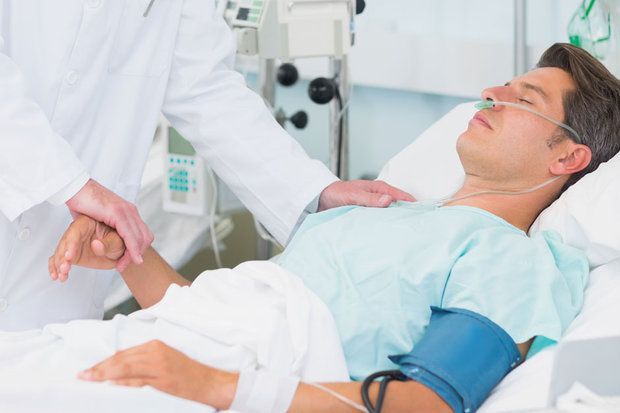
To simplify differentiation, doctors distinguish the following degrees of coma during strokes:
- 1st degree. It is determined by lethargy or loss of consciousness with preservation of reflexes. This is mild damage to brain cells during a stroke and slight depression of the functions of the nervous system. At the same time, skin reflexes are weakened and muscle tone is increased;
- 2nd degree. It is diagnosed by the patient falling into deep sleep, lack of response to external stimuli, skin reflexes and pain;
- 3rd degree. It is caused by extensive hemorrhage and is determined by the absence of many reflexes, consciousness, and the reaction of the pupils to light;
- 4th degree. It is not comparable to life, as it is characterized by the absence of spontaneous breathing, a sharp decrease in pressure and hypothermia. All reflexes are absent. A patient in this stage of coma has virtually no chance of returning to normal life.
Stunned consciousness: treatment methods
When an individual enters a medical facility, the state of stupor and stupor should be clearly differentiated, since these disorders have many similar symptoms. To do this, it is necessary to take into account that stupor indicates the existence of some kind of psychotic disorder in the patient, while at the same time, stunning syndrome is a reflection of disruptions in the physiological functioning of the body.
If a person is suspected of developing stunned syndrome, he must be urgently taken to the nearest hospital. Before the ambulance arrives, it is necessary to place the victim in a horizontal position. During the hot season, the victim should be moved to the shade. If you suspect overheating, you need to put a heating pad with ice on his head or apply a cold compress. It is necessary to provide the subject with full breathing; to do this, loosen all constricting elements of clothing. The person next to the patient needs to try to keep his attention; to do this, he needs to talk to him and ask questions on neutral topics. Primary actions in a medical institution include the following activities
:
- measurement of blood pressure, pulse, body temperature;
- external assessment of the patient’s condition, examination for the presence of traumatic injuries;
- performing laboratory tests of blood and urine;
- study of neurological status;
- examination by a psychiatrist;
- conducting linguistic tests;
- use of neuroimaging research methods.
In the future, the treatment regimen for stunning syndrome is selected on an individual basis after establishing the exact cause that caused the depression of consciousness. The main emphasis in treatment is on eliminating the factors that provoked a malfunction in a person’s mental activity. If the development of a diabetic coma is suspected, the patient is administered insulin medications. In case of acute or chronic autointoxication syndrome, plasmapheresis is performed - blood purification. If an overdose of drugs is established, the patient is given an appropriate antidote. If the cause of depression of consciousness was an infectious disease, a treatment regimen with antibacterial agents is chosen. Treatment of stupor also includes the use of drugs that ensure proper breathing and restore normal cerebral blood supply. Detection of a subdural, epidural or intracerebral hematoma of the brain requires emergency surgical intervention.
How to treat and what will happen if you don’t treat
First, the clinic’s specialists diagnose the degree of the disorder and determine what the problem is, and then carry out speech therapy work: they do finger, articulation and breathing exercises so that speech is synchronized with breathing, correct and reinforce the correct pronunciation of sounds, and work on the expressiveness of speech.
Just as with aphasia, it is important to start correcting dysarthria as early as possible. Speech defects become habitual, so the later you go to the clinic, the more difficult and longer it will be to restore articulation, and this is not an easy process - remember adults who have had a lisp since childhood or cannot pronounce the letter “r”.
Care and treatment of patients in a coma
With impaired consciousness, post-stroke coma is accompanied by spontaneous breathing and heartbeat. The duration of coma during a stroke cannot be predicted, so special care is required for the patient.
Here are some recommendations:
- Nutrition. Since comatose patients are fed through a special tube inserted into the stomach, the food must have a liquid consistency. Baby food is ideal for this: formula milk or fruit and vegetable purees in jars.
- Hygiene. To prevent the development of ulcers and bedsores and maintain body cleanliness, it is necessary to treat the patient’s skin daily with soapy water or special products, as well as clean the patient’s oral cavity with wet gauze wipes. Comb your hair daily (especially long hair) and wash your hair at least once a week.
- Change of position. To prevent bedsores, the patient should be systematically turned in different directions.
In case of extensive hemorrhagic stroke, surgical removal of the hematoma inside the brain is indicated, increasing the chances of recovery.
Coma resulting from an ischemic stroke is treated in a specialized intensive care unit of the neurological department. If life-support functions are impaired, the patient is connected to an artificial lung ventilation device (ALV) and a monitor that records the body’s parameters. Euthanasia is prohibited in Russia, so a person’s life will be maintained for as many days as required.
For ischemic stroke the following is prescribed:
- anticoagulants (aspirin, heparin, warfarin, trental);
- nootropic drugs (Cavinton, Mexidol, Actovegin, Cerebrolysin).
Once in a coma after a brain stroke, a person requires constant care. First of all, he needs trained medical staff.
The patient needs to be fed regularly and measures to prevent the occurrence of bedsores must be provided. In a coma, the patient does not feel anything and is not capable of movement, therefore, without taking preventive measures, bedsores are sure to appear.
The patient must be protected from infection and maintained in physical condition. Medical care includes providing the patient with the necessary vitamins and microelements.
What dangers are fraught with perinatal encephalopathy - details of treatment and prevention of the disease in children.
Types of hallucinations in cancer patients
The manifestation of hallucinations can take place according to the following plan:
- Minor visual manifestations that appear sporadically.
- Complex pictures, at first only visual , then they are accompanied by sounds and smells.
- Ionic states, when the patient sees strange images with his eyes closed, as if pictures and scenes are flashing through. The phenomenon is closer to dreams during wakefulness, since there is passive observation.
- Gradual appearance of more vivid images, often with an obsession with stalking .
On this topic
- General
What is a cancer examination
- Natalya Gennadievna Butsyk
- December 6, 2020
Hallucinations in patients are often a continuation of sleep, that is, the person wakes up, but continues to see something that is not really there, as if living in a dream. Cancer patients often see figures of their doubles.
It is characteristic that most hallucinations in cancer patients are accompanied by an acute, almost hysterical feeling of fear. But if in case of heart or lung diseases there are single pictures, then in case of cancer these are entire films with nonsense. The greater the stage, the stronger the damage to the organs, the stronger and more emotional the pictures that turn into an amentive-delirious state, which are created by a poisoned and inflamed brain.
Coming out of a coma
Patient care
- The swallowing function returns (weakly expressed), the skin and muscles react to external manifestations. A person reflexively moves his limbs and head. The doctor predicts positive development.
- The patient begins to delirium, hallucinations are possible, consciousness returns, memory, vision and partially speech functions are restored.
- Motor activity resumes: the patient first sits, then slowly gets up and subsequently walks with support.
When consciousness returns, the patient is shown a tomographic study to determine the extent of brain damage and select a method for subsequent recovery.
The rehabilitation process takes a long time and requires moral and physical strength from both the patient and relatives.
Stroke and coma are accompanied by destruction of brain cells and loss of vital body functions. The goal of rehabilitation is to ensure that these processes do not spread to other areas of the brain. To do this, every day for a long time, people must perform gradually more complex special gymnastic exercises.

Recovery exercises
The task of the relatives of the victim as a result of a coma is to help get out of this state, creating the most favorable moral and psychological conditions for the rehabilitation period.
When recovering from a coma, the restoration of lost reflexes occurs slowly:
- The first to return are the swallowing and skin reflexes.
- There may be hallucinations, a gradual return of memory, and speech is partially restored.
- Resumption of physical activity is possible after a long rehabilitation period.
Reference: Currently, neurologists are testing a method where the cerebral cortex is stimulated with electromagnetic pulses. The effectiveness of the method is confirmed by cases of patients returning from a coma.
How to bring a person out of a coma? Doctors strongly recommend that those around the patient maintain communication, read books, talk, sing, stroke, hug and kiss. Stories from loved ones about current events, shared memories of the past, and funny stories will help restore brain activity.
Important! Experiments have confirmed that patients who are constantly surrounded by close people emerge from a comatose state earlier than others.
Postoperative psychosis
Postoperative psychosis
– acute disorder of consciousness that occurs immediately or within two weeks after surgery.
It manifests itself as a complex of symptoms: hallucinations, delusions, motor agitation or retardation, disturbance of orientation in space, time and self. Memory, thinking, and speech disorders often develop. The state of delirium may be continuous or alternate with periods of clear consciousness.
Diagnosis is based on clinical methods - observation and conversation. Treatment includes drug therapy and the creation of favorable conditions for recovery.
The official name for postoperative psychosis used in ICD-10 and DSM-IV is postoperative delirium. Other synonyms are acute cerebral insufficiency, acute confusion after surgery.
This disorder is one of the most common complications in elderly patients, significantly prolongs hospitalization and increases the risk of death. According to statistics, the prevalence of psychosis after surgery in people over 60 years of age is 15-65%.
In young patients, this complication is extremely rare, and only isolated cases have been described in children.
Postoperative psychosis
Among the factors for the development of delirium, two groups are distinguished: those that increase the risk of developing complications and those that are direct causes (triggers).
The likelihood of psychosis is higher in elderly and senile patients with dementia, depression, visual or hearing impairment, hypoalbuminemia, renal failure, taking narcotic analgesics, benzodiazepines, drugs with anticholinergic effects, alcohol abuse, and smoking. Immediate causes include:
- Anesthesia.
Acute psychosis develops 2-3 days after the use of general anesthesia. It is more often diagnosed after operations on the heart, gastrointestinal tract, and brain. - Complications during the operation.
Delirium occurs after intraoperative blood loss and blood transfusion. Consciousness becomes a result of cerebral circulatory disorders. - Postoperative somatic complications.
A psychotic disorder is formed with severe pain, eating disorders, and bladder catheterization. Less commonly, the cause is anemia, water and electrolyte disturbances.
The pathogenetic basis of postoperative psychosis is neuronal dysfunction, which develops as a result of hypoxic, dysmetabolic and toxic damage to nervous tissue. There are usually no structural changes.
An imbalance of neurotransmitters and a decrease in the rate of interneuronal transmission are determined. Pathological processes are diffuse, spreading in the cerebral cortex and subcortical structures.
According to neurophysiological studies, the most significant factors in the development of delirium are cholinergic deficiency and the body’s general pathological reaction to stress—surgery.
The dynamics of psychosis are characterized by an acute onset, a fluctuating course (circadian rhythm of symptoms worsening at night) and a transient nature (manifestations resolve within a few days or weeks).
Forms of postoperative psychosis differ in clinical picture (predominant psychomotor symptoms). This classification allows clinicians to promptly identify the disorder, select the most effective, safe therapy, organize favorable living conditions for the patient, and make a prognosis for recovery. There are three types of delirium:
- Hyperactive.
Characterized by pronounced psychomotor activity, anxiety, and excitability. - Hypoactive.
It manifests itself as detachment, lethargy, apathy, and decreased motor activity. - Mixed.
Activity levels vary throughout an episode of delirium.
With the development of postoperative delirium, confusion and attention disturbances are determined. Patients are absent-minded, disoriented in time, location, and cannot concentrate on the topic of conversation.
A disorder of cognitive functions is manifested by a distortion of perception, on the basis of which delusions, illusions, and hallucinations (usually visual) are formed. Speech becomes incoherent. Patients have difficulty understanding the questions of others and cannot remember recent events.
With mild intellectual impairment, communication is accessible; the difficulty is caused by conversations on topics abstracted from the specific situation.
Psychomotor disorders are characterized by hyperactivity, hypoactivity, or alternation of these states. Hyperactive patients are easily excitable, wary, restless, and motorly disinhibited. Speech is loud, persistent, emotions are clearly expressed.
In an acute state, they can pose a threat to their own health and to others. Hypoactive patients behave detached, lethargic, and hypodynamic. They hardly speak, they move slowly.
With a mixed type of delirium, psychomotor agitation suddenly gives way to inhibition and vice versa.
Most patients have sleep-wake rhythm disorders, manifested by insomnia, total loss of sleep, and inversion of circadian rhythms.
At night, symptoms intensify, and nightmares often occur, which continue as hallucinations upon awakening. Emotional reactions are inappropriate.
In the hyperactive form of psychosis, states of anxiety, fear, irritability, euphoria, and confusion predominate. Hypoactivity is accompanied by emotional “emptiness,” apathy, and confusion.
If detected late and not treated promptly, psychosis slows down the postoperative recovery process in older people. Rehabilitation is delayed, secondary complications arise associated with prolonged immobilization and hospital stay.
Separation from loved ones and the inability to return to normal life negatively affects the emotional state of patients. A gloomy, pessimistic vision of the future begins to prevail, and ideas of self-harm are formed.
The lack of positive dynamics in the treatment of delirium leads to complete social maladjustment of patients, the need for constant care, and the development of dementia.
The initial assumption about postoperative psychosis is made by the surgeon and the doctors of the intensive care unit. The diagnosis is carried out by a psychiatrist.
In 80% of cases, clinical methods are used to make a diagnosis.
Additional use of psychodiagnostic tests may be necessary in cases of hypoactive delirium with mild symptoms. An integrated approach to the examination includes:
- Conversation.
The psychiatrist evaluates the productivity of contact with the patient, his ability to answer questions, the preservation of temporal and spatial orientation, and a critical attitude towards his own condition. Detects the presence of speech, memory, attention, and thinking disorders. - Observation.
The attending physicians, together with the psychiatrist, determine the adequacy of behavior and emotional reactions. With hyperactive psychosis, patients do not comply with routine rules, are disinhibited, affectively excited, and their actions do not correspond to the situation. - Pathopsychological examination.
A clinical psychologist conducts a series of tests confirming a decrease in intellectual functions. Difficulties arise with simple tasks - counting forward and backward, drawing geometric shapes, memorizing words, retelling texts. Moderate and severe cognitive impairments are detected.
The psychiatrist finds out the reasons for the development of psychosis, and, if they continue to affect the patient’s condition, takes measures to eliminate them: discusses with the surgeon the possibility of replacing medications, canceling procedures that limit movement (catheterization), prescribing more potent painkillers, and returning to the usual regimen. Therapy is carried out in the following areas:
- Stimulation of mental activity.
It is important to create conditions for the patient to demonstrate cognitive interest and social activity. For this purpose, meetings with relatives, watching television programs, films, and reading books are organized. During the conversations, the patient’s location, health status, well-being, and forgotten personal data are discussed. - Maintaining physical activity.
To restore circadian cycles, constant lighting is maintained during the day and treatment procedures at night are limited. If possible, walks and exercise therapy classes with an instructor for 10-15 minutes are prescribed. - Drug relief of symptoms.
Pharmacological treatment is carried out with drugs from several groups. Medicines are selected by the doctor individually. Cholinesterase inhibitors, antidepressants, antipsychotics, and benzodiazepines are used.
With proper timely treatment, the prognosis for postoperative psychosis is favorable.
Prevention consists of taking into account and minimizing risk factors before performing a surgical procedure - it is necessary to stop drinking alcohol, smoking cigarettes, and consult with a doctor in advance about the possibility of replacing or canceling medications taken (narcotic analgesics, anticholinergics, etc.).
), undergo treatment for chronic diseases. After surgery, it is important to prevent the development of complications, including infectious ones, to provide adequate pain relief, and to organize active leisure for the patient - walking, reading, visits with family.
Source: https://www.KrasotaiMedicina.ru/diseases/psychiatric/postoperative-psychosis
Recommendations for relatives of patients after coma

A person emerging from a coma requires increased attention.
To avoid the recurrence of apoplexy, the following recommendations must be observed:
- inspire hope for recovery;
- create a favorable psychological climate and comfortable environment;
- motivate for daily exercise and praise for success;
- master manual massage skills.
Only love, care and attention can work miracles. Love and take care of yourself and your loved ones, and a favorable prognosis will not be long in coming.
How to recognize an approaching coma
After a cerebral stroke, coma often appears, especially in older people, but its signs are ignored by the patient.
After recovering from unconsciousness, a person may remember the following symptoms:
- speech disorder;
- yawning;
- severe dizziness;
- rapid breathing;
- pallor;
- paresthesia with numbness or tingling in some parts of the body.
To prevent pathological processes from appearing in brain cells, you need to take your well-being seriously and lead a healthy lifestyle.
You should also remember the signs of the onset of the disease and, if they appear, immediately seek medical help.
Basically, coma is a consequence of a vegetative state. The patient's recovery depends on the cause, location, severity, and extent of brain damage.
Causes
First of all, the state of stupor is caused by acute disorders of the nervous system, which are observed:
- for infections, tumors, inflammatory processes of the brain;
- alcohol, drug, intoxication poisoning;
- trauma and brain damage;
- strong emotional shocks.
Stunning is physiologically similar to the process of falling asleep. For example, during deafness, a person may feel darkening in the eyes, while sounds are removed and turn into ringing. Unlike other disorders of consciousness, for example, delirium, oneiroid, in a state of deafness a person does not have productive disturbances of perception (hallucinations).

